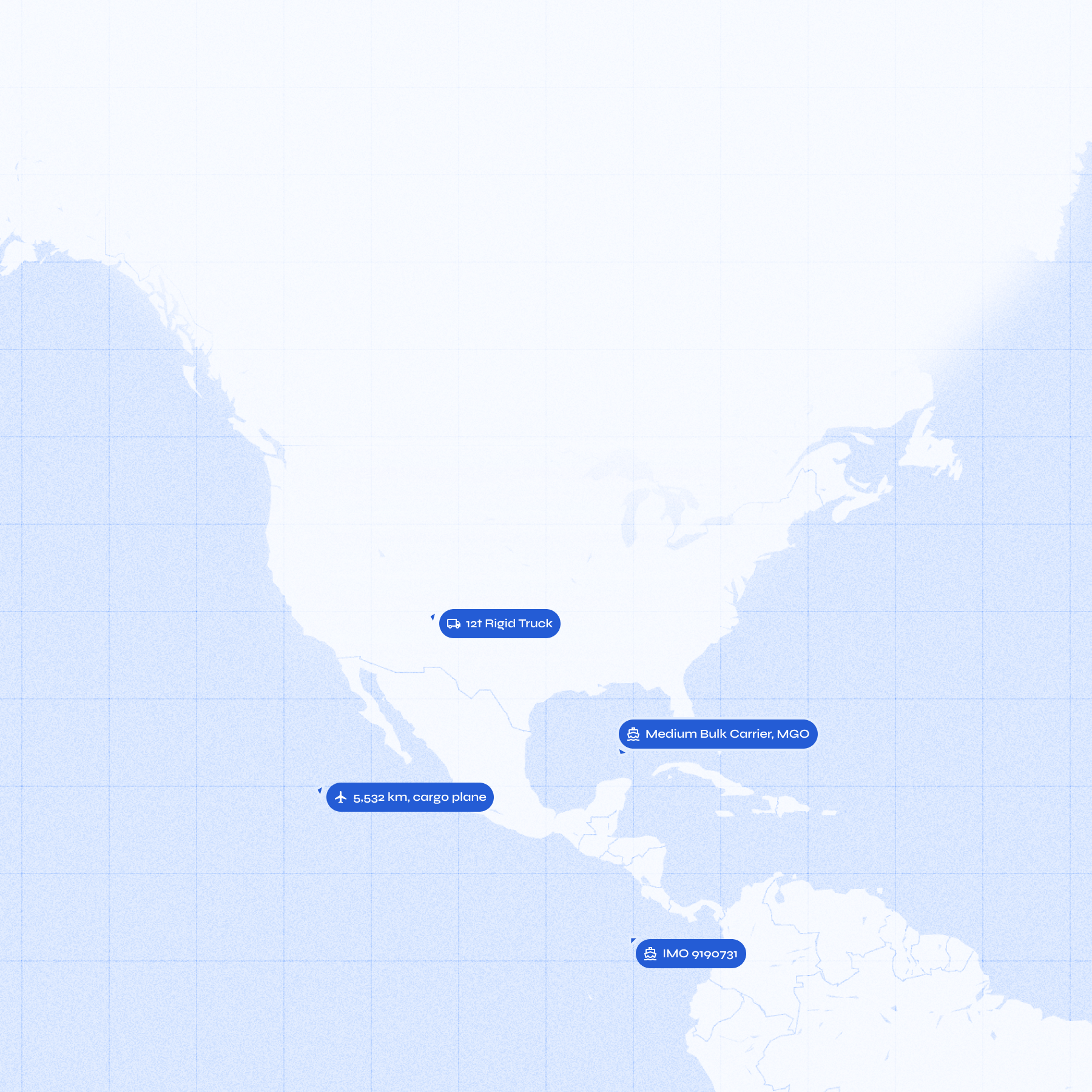
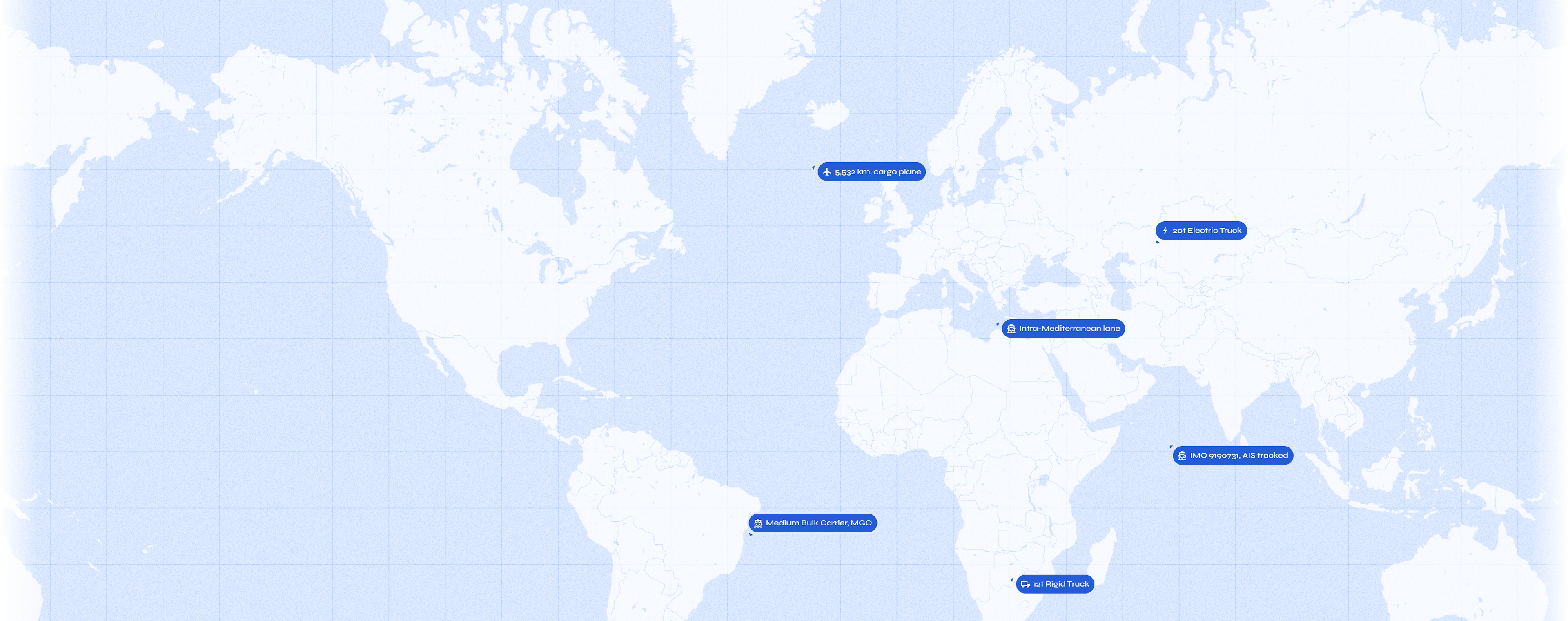
Meet increasing demand for emissions reductions in logistics. Fast.
Your customers expect green shipping options and logistics emissions tracking. Capture this demand by embedding emission calculations and carbon insets and offsets into your logistics platform.
Meet increasing demand for emissions reductions in logistics. Fast.
Your customers expect green shipping options and logistics emissions tracking. Capture this demand by embedding emission calculations and carbon insets and offsets into your logistics platform.
Meet increasing demand for emissions reductions in logistics. Fast.
Your customers expect green shipping options and logistics emissions tracking. Capture this demand by embedding emission calculations and carbon insets and offsets into your logistics platform.
Meet increasing demand for emissions reductions in logistics. Fast.
Your customers expect green shipping options and logistics emissions tracking. Capture this demand by embedding emission calculations and carbon insets and offsets into your logistics platform.
Win new customers
Capture growing demand for scope 3 emission reporting and reducing the carbon footprint in logistics.
Win new customers
Capture growing demand for scope 3 emission reporting and reducing the carbon footprint in logistics.
Cultivate customer loyalty
Inform your customers decarbonisation strategy with decision-useful carbon analytics.
Cultivate customer loyalty
Inform your customers decarbonisation strategy with decision-useful carbon analytics.
Build a climate positive legacy
Enable your customers to compensate for shipping emissions using carbon insetting and offsetting.
Build a climate positive legacy
Enable your customers to compensate for shipping emissions using carbon insetting and offsetting.
Go live, fast
Secure immediate results via API integration, spreadsheet upload, or CargoWise plugin.
Go live, fast
Secure immediate results via API integration, spreadsheet upload, or CargoWise plugin.
Add shipping emission estimates to your tender in minutes
Learn moreIndustry-leading logistics emission intelligence for compliance, and beyond
Fast-track your customer's climate compliance by exceeding the industry-standard for emission calculations. Lune's emission calculation methodology is anchored in the industry-leading GLEC Framework, ensuring accuracy and reliability. Audited and accredited by the Smart Freight Centre, and compliant with ISO 14083, our robust calculations are report-ready.
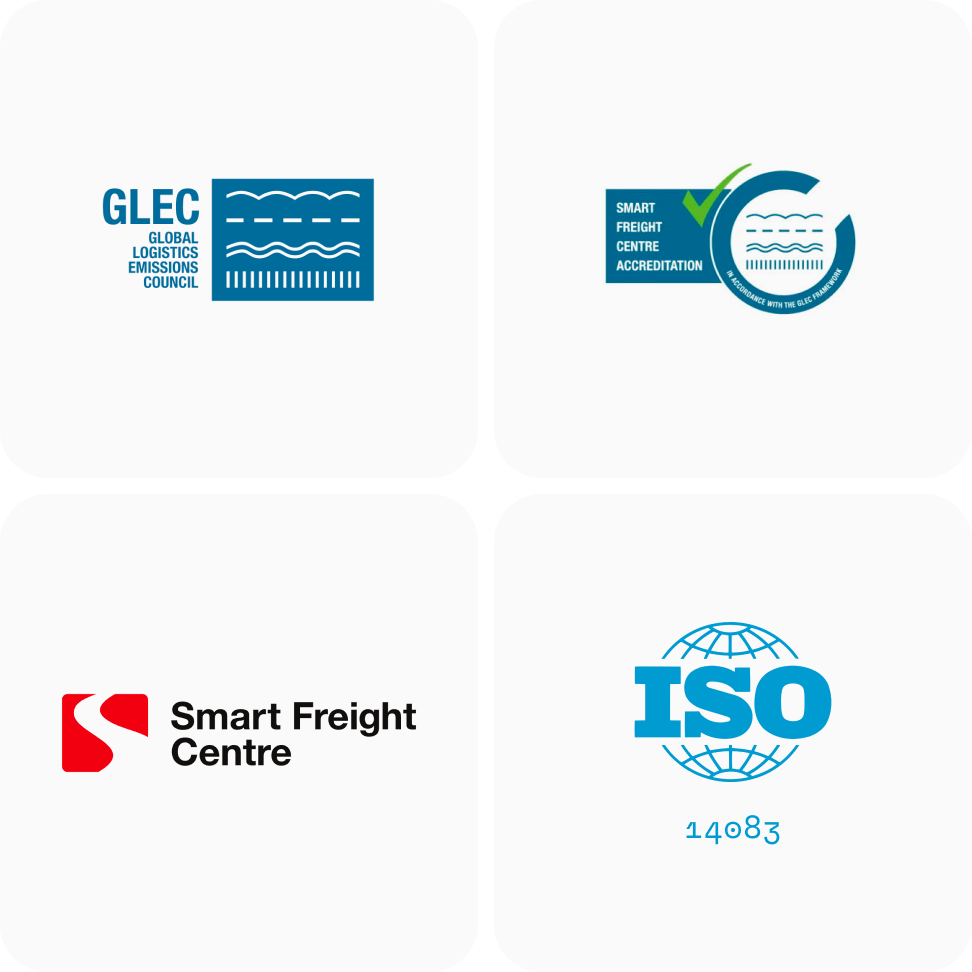
Granular, multimodal, precise
Elevate your client’s supply chain management with granular calculations. Tackle complex single and multi-leg shipments across more than 100 transport methods, warehousing, and terminal operations.
Increase data quality without extra data collection costs
Plug holes in your data to return the accurate logistics emissions data your customers need to decarbonise. Lune emission intelligence uses your data to infer exact vessel used, actual distance traveled, and more.
or transshipment points
specify size, cargo, and fuel.
Out-of-the-box emission reporting for logistics customers
Cultivate customer loyalty with Lune's decision-useful carbon analytics page generated for each of your customers. Accelerate their sustainability goals by pinpointing emission hotspots across transport modes, highlighting the greenest route, and tracking decarbonisation over time.

Audit-ready calculation breakdowns
Streamline your customers’ climate compliance with step-by-step per leg emission calculation breakdowns. Be confident in actioning your data using Lune’s data quality score to gauge quality.

High quality insets and offsets with unparalleled transparency
Cultivate customer loyalty and advance their sustainability goals by embedding carbon insets and offsets into your customer experience. Our experts rigorously vet climate projects against a six-point criteria to deliver measurable impact and peace of mind. See where your customers’ climate contributions go using Lune's industry-leading, transparent, and traceable project impact summaries.
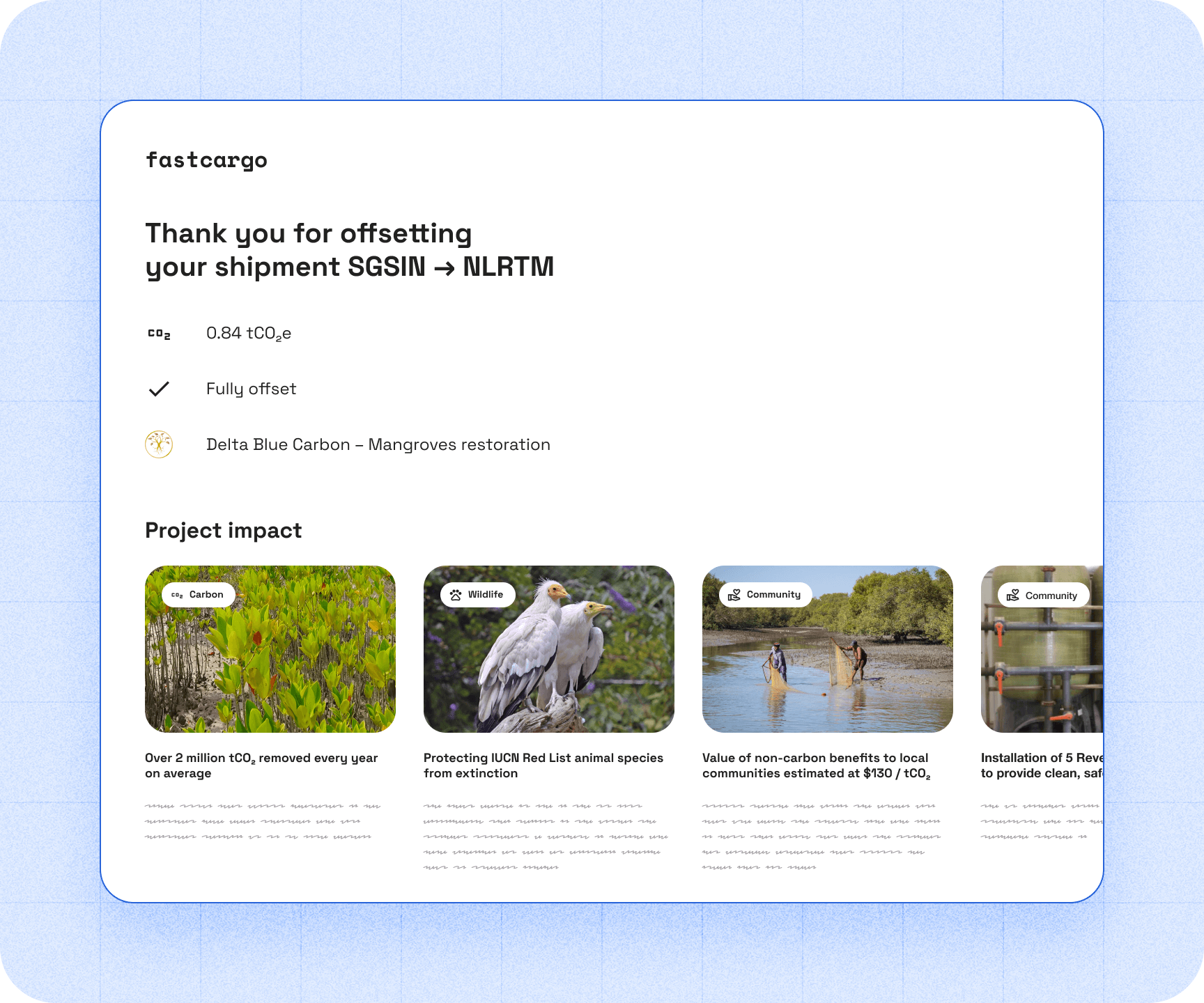
Reduce shipment emissions, effortlessly
Lune’s new emissions reduction recommendations make it easy to identify, advise, and explain greener options to shippers that reduce their logistics emissions. No sustainability degree required.

Greening the supply
chain
Explore the environmental impact of supply chains, investigate the push and pull factors changing the logistic landscape, and strategies sustainability leaders are already implementing to reach net zero.
How to get started
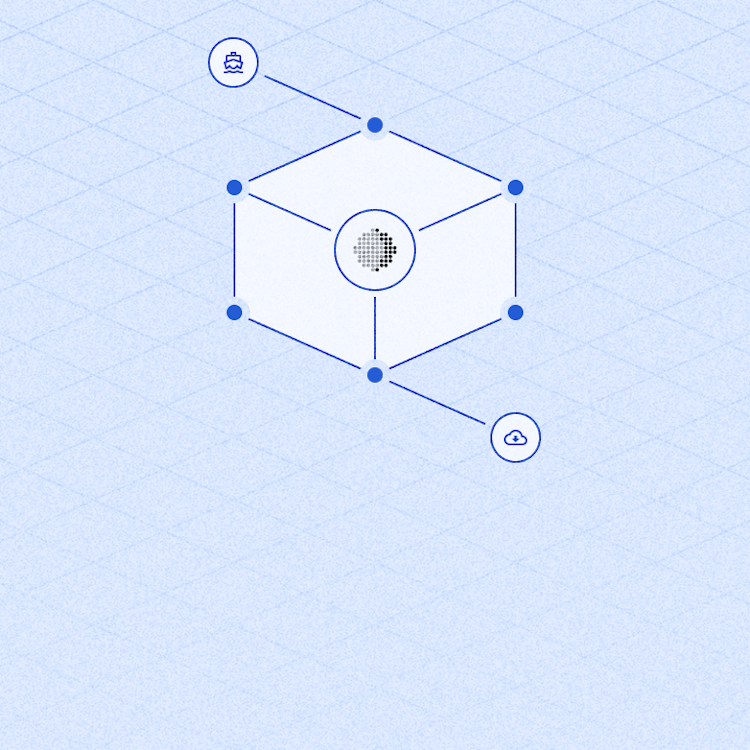
Seamless API integration
Integrate within hours with support from our engineers.
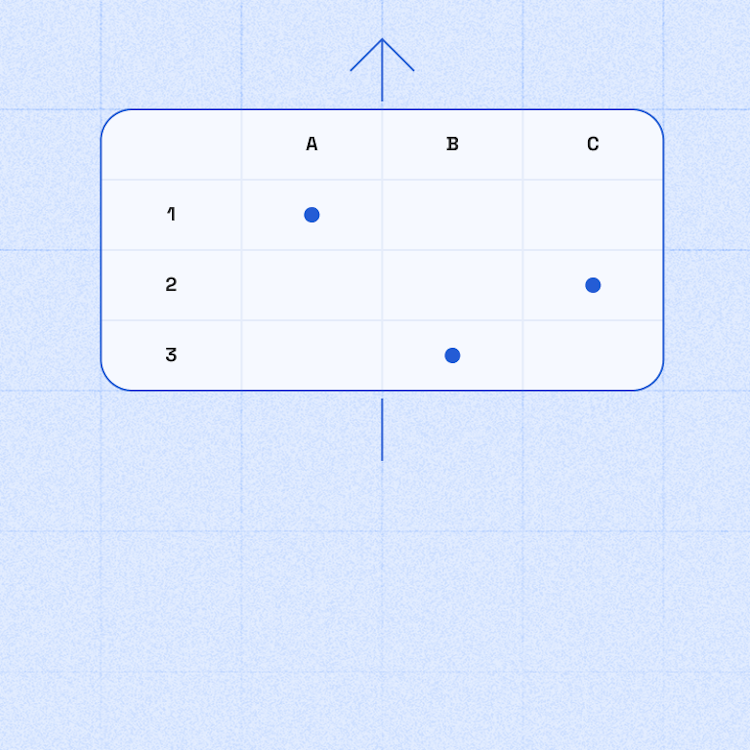
Simple spreadsheet upload
Get started immediately and upload your logistics data via spreadsheet.

Plug into a third-party
Activate Lune’s Cargowise or BlueYonder plugin. No code required.
30+ freight forwarders winning tenders using Logixboard's CO₂ emissions reporting tool
Lune was the best partner for translating detailed information into something understandable. Instead of just presenting all of the data and hoping someone can make sense of it, the Lune team knew how to curate the data and make it understandable to people.

Erin Miska
Product Marketing Manager at Logixboard30+ paying customers
1,100,000+ shipments
FAQs
How can Lune help reduce CO2 emissions in logistics?
How can Lune help reduce CO2 emissions in logistics?
- Track and calculate their scope 1, 2, or 3 emissions
- Report on their emissions with audit-ready reports and detailed analytics
- Act on emissions reduction recommendations backed by reliable data
- Offset their carbon emissions with reliably vetted climate projects
What data need to calculate shipment emissions?
What data need to calculate shipment emissions?
- Load
- Mode
- Distance
How does Lune calculate logistics emissions?
How does Lune calculate logistics emissions?
- Extract existing data from your platform: such as shipment mode, distance/locations, weight, container specs, and fuel type
- Enhance with emissions intelligence: to increase the accuracy of inputs e.g. tracking actual distances travelled using just carrier names and dates
- Apply GLEC factors: using ISO 14083–compliant GLEC emission rates (g CO₂e/ton-km)
- Deliver and score: this includes total CO₂e, audit-ready breakdowns, and a data-quality confidence score.
How long does it take to implement Lune’s emissions intelligence?
How long does it take to implement Lune’s emissions intelligence?
- API integration: Go live within hours
- Spreadsheet upload: Start immediately by uploading your logistics data - no code required
- Third-party plugins: Activate the CargoWise or BlueYonder plugin and be live the same day

